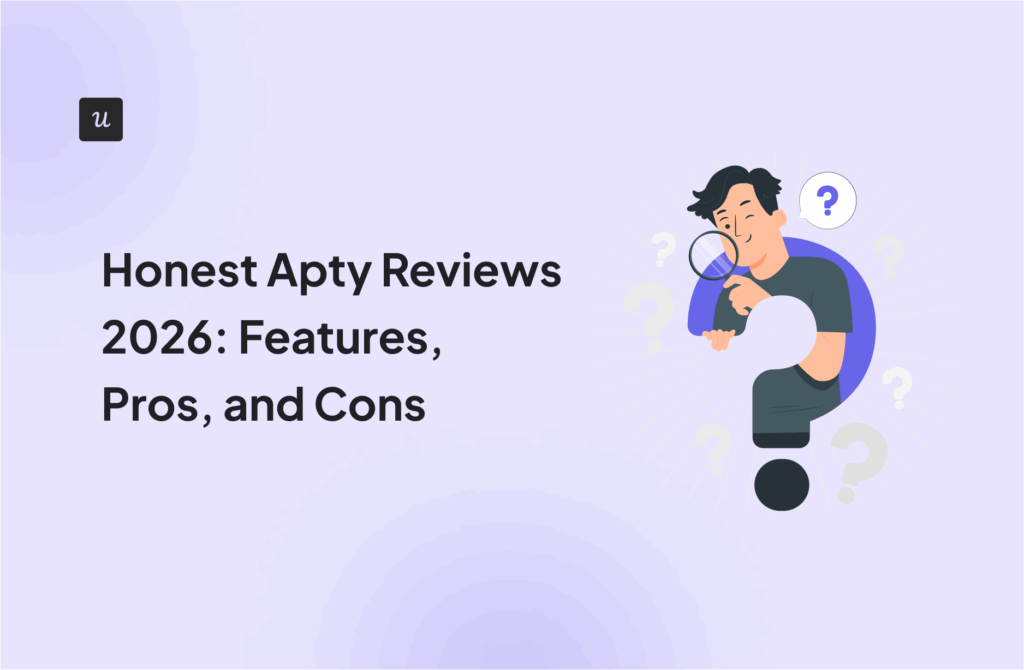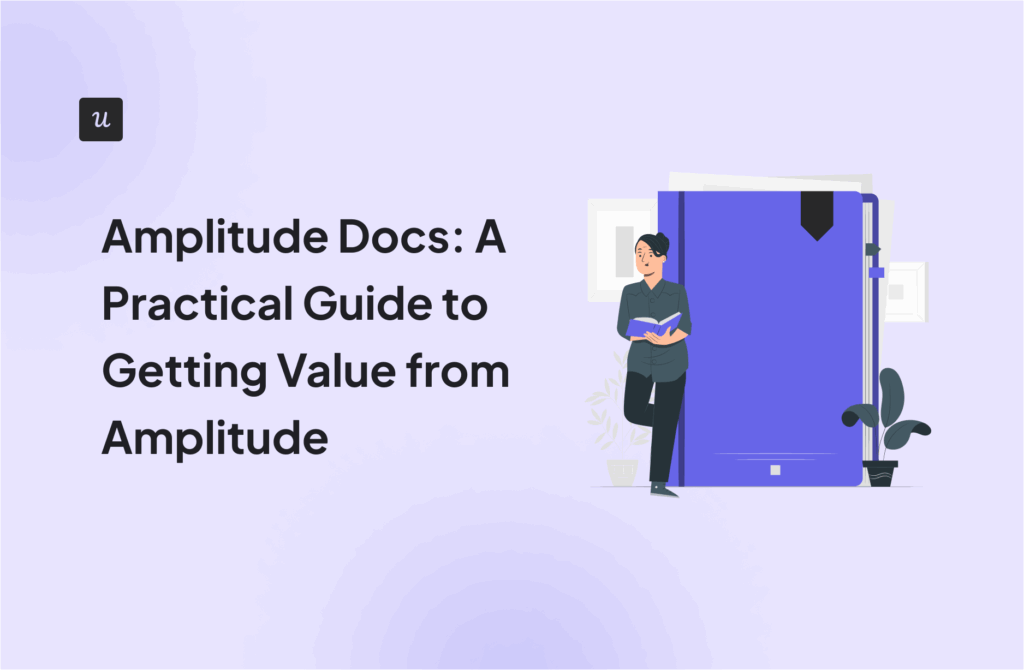Are you looking to track your customer data and build your sales and marketing efforts around it? You can do that by choosing the right customer tracking software for your business. However, it’s not easy to pick a tool among the myriad available on the market.
To help you out, we’ve come up with a list of the 13 best customer-tracking software solutions in the industry. We’ve broken them down into three categories, including product analytics.
Let’s dig in!
What’s your biggest challenge with understanding your customers?
How are you currently tracking customer data?
What is the primary goal for your new customer tracking software?
You’re ready for a smarter approach.
Based on your answers, a product-led growth platform is the perfect fit. See how Userpilot’s customer tracking software can help you analyze user behavior and build better product experiences.
Try Userpilot Now
See Why 1,000+ Teams Choose Userpilot

What is customer tracking software?
Customer tracking software allows businesses to monitor and analyze a customer’s behavior and activity across different channels and touchpoints. This helps salespeople map out the customer’s readiness to convert.
For example, customer tracking software should let you review individual website visits, purchase history, or clicks on social media ads.
Must-have features of customer tracking tools
When looking for customer tracking software, make sure you don’t skip these features:
- Customer tracking system. The tool should let you collect, monitor, and track your customers’ behavioral event data, path activity, and flow usage, depending on your needs.
- Dashboards for customer data analytics. You want this tool to have a centralized dashboard or report to view your metrics in data analytics charts, but also see progress toward goals. This helps you make faster data-driven decisions.
- User segmentation. Not all of your users will behave the same, and you don’t need them to. However, you need the option to view their activity separately through customer segments.
- Integrations. You want your customer tracking software to connect seamlessly with the other tools in your tech stack. Take a look at Userpilot integrations.
You might also want your tool to have a short learning curve and to be truly no-code.
Best customer tracking software for product insights
To gain insights about your product by tracking customer behaviors, i.e., understand whether or not a feature is easy to find, take a look at these tools:
Userpilot
Userpilot is a no-code, all-in-one platform for product teams focusing on platform-led growth. It comes with engagement and analytics features to review user behavior throughout the customer journey.
Userpilot is mostly suited for SaaS companies of any size as it focuses on in-app product enrichments.
With Userpilot, you can plan product activations and see if they’re working on the same app.
“This level of customization and ease of use [regarding onboarding flows] empowers our marketing team to effectively tailor user experiences, leading to improved user engagement and satisfaction. Additionally, the real-time analytics feature provides invaluable insights.” – Userpilot user, Yuval W.
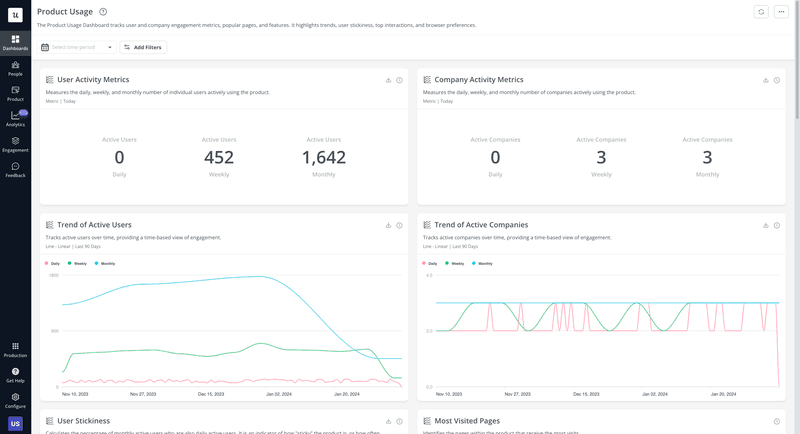
Main features
- Automatic user behavior tracking for product experiences. Track customer engagement with onboarding tooltips, walkthroughs, and pop-ups. Then, see how that impacts user behavior and product metrics.
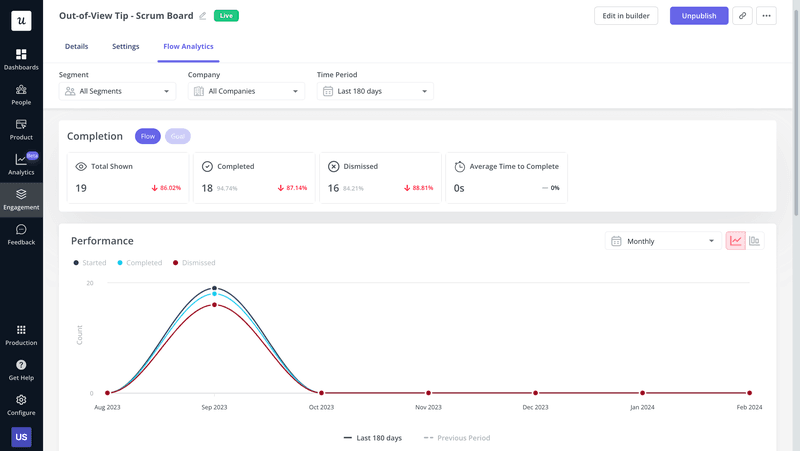
- Event tracking. Create and track events to capture where your users click, hover, and interact with your product by installing a simple JS snippet.
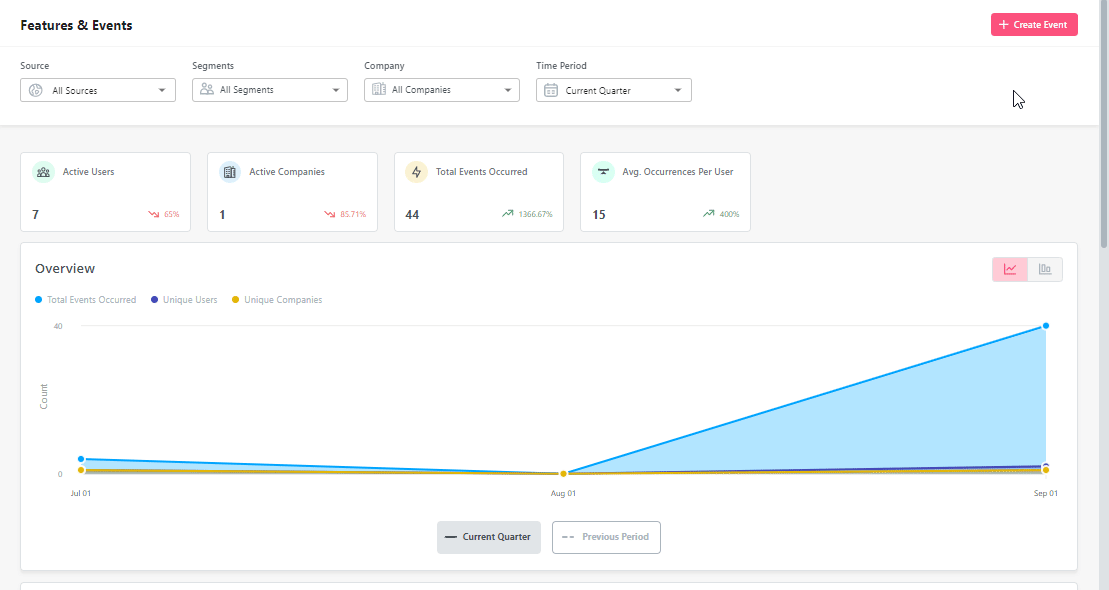
- Reports. There are different types of product metrics, include them all in your data analysis reports by leveraging the captured event data. Use reports to share actionable insights with stakeholders.
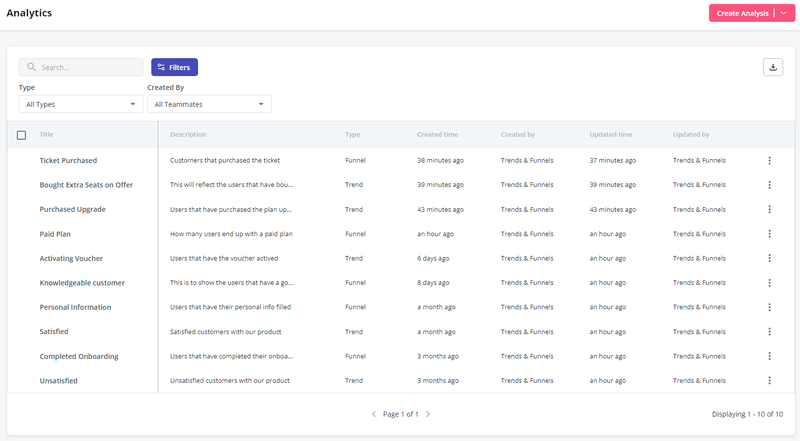
- All-in-one analytics dashboards. Review your performance by analyzing your funnels, paths, and retention metrics in one place. Your dashboard helps you find actionable insights to improve customer satisfaction. See examples of users’ flow and populate data analysis reports in seconds.
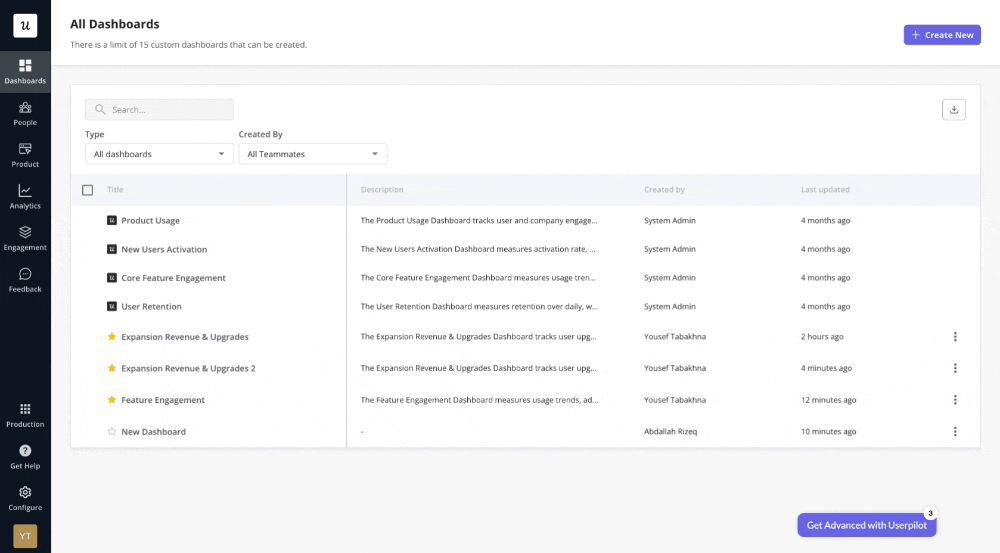
- Track user satisfaction. Make sure your customer satisfaction metrics stay green by adding in-app surveys and calculating your NPS.
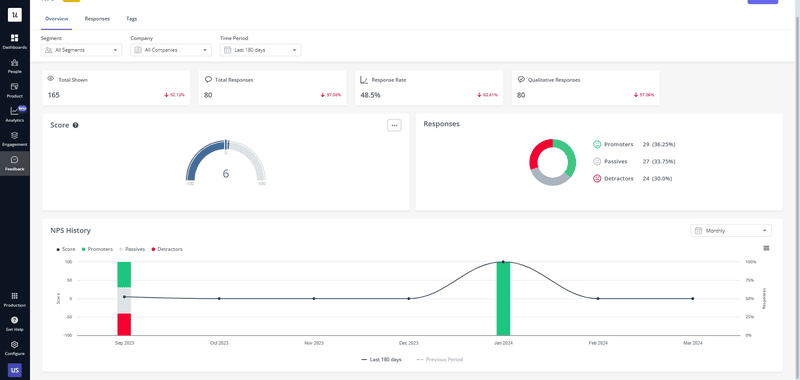
Use Attention Insight as an example. This AI-powered customer tracking tool increased its user activation by 47% after adding interactive product walkthroughs. Read Attention Insight and Userpilot’s case study.
Pricing
Userpilot offers flexible pricing based on your monthly active users (MAUs). Plans start at $299 per month for smaller teams and scale as your user base grows.
Below are the pricing tiers you can choose from:
- The Starter plan begins at $299/month (billed annually) for up to 2,000 monthly active users. It includes in-app user engagement, usage trend analysis, NPS surveys, and essential product analytics—ideal for mid-market SaaS teams getting started.
- The Growth plan offers custom pricing and adds advanced analytics, retroactive event auto-capture, in-app surveys, session replay, and more. It’s the most popular choice for growing teams that need deeper insights and scale.
- The Enterprise plan offers custom pricing and includes everything in Growth, plus bulk data handling, custom roles and permissions, SOC 2 Type 2 compliance, and enterprise-level support.

Amplitude
Amplitude Analytics is a product and web analytics tool that helps you understand customer’s behaviors through data.
It’s catered to multiple industries, including finance, B2B, e-commerce, media, and healthcare firms. It comes with Amplitude Pathfinder for reviewing users’ paths on your tool.
While it claims to be fully no-code, users say otherwise. “It would be great to have a no-code way of getting events into the platform. Currently, I need to talk to engineering and get the metrics implemented,” shares Amplitude user, Sourabh A.
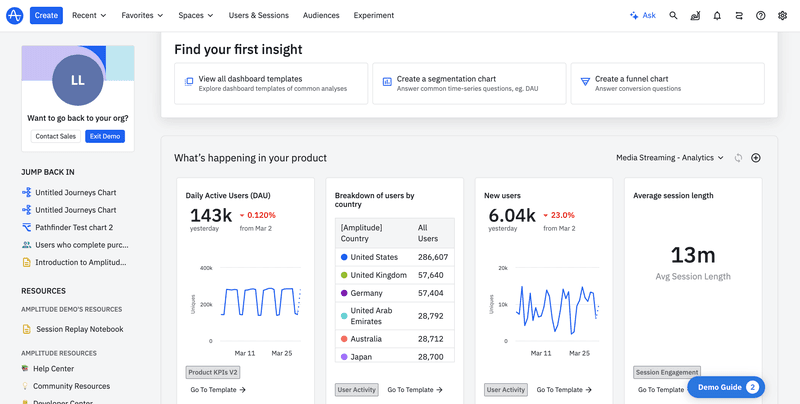
Additionally, unlike some other tools, it is mainly designed for analyzing behaviors and does not collect other types of customer data such as satisfaction metrics.
Main features
- Centralized dashboard. Salespeople can see their customer’s activity on a simple dashboard to make quick insights.
- Alerts. Amplitude allows users to get notified about KPIs to spot and fix issues before they become problematic.
- Amplitude’s charts. Get access to different types of charts to visualize behavioral customer data throughout the lifecycle. Amplitude lets you view relevant data to understand, convert, retain, and monetize users.
Pricing
Amplitude’s pricing plans are feature and usage-based, so they increase as you grow.
It’s free for individuals and goes up to $49 per month (billed annually) for 1,000 monthly tracked users. There are no limitations on team members.
It also offers two other plans (Growth and Enterprise) but prices are only available through a custom quote.
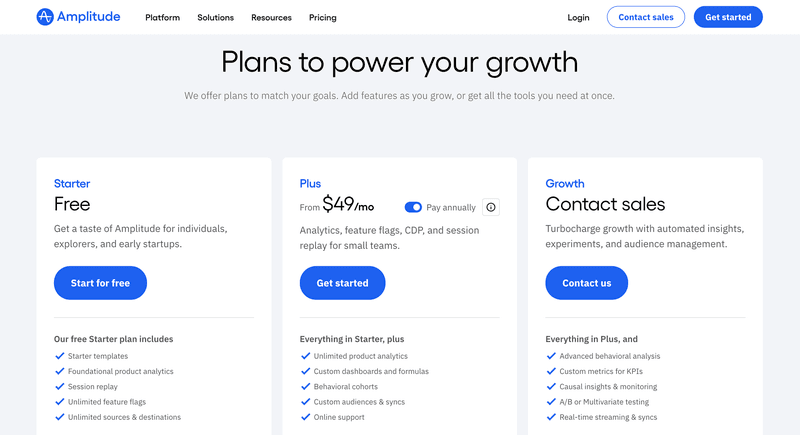
Mixpanel
Mixpanel Analytics lets you collect and analyze behavioral customer data to drive product growth.
It offers advanced analytics at an affordable price for medium-sized businesses and supports client- and server-side tracking through an SDK (software development kit).
Users enjoy its interactive dashboard but wish it was easier to explore. See this user review from Mohammed A.: “The dashboards work fantastically. However, the user interface needs to be more user-friendly.”
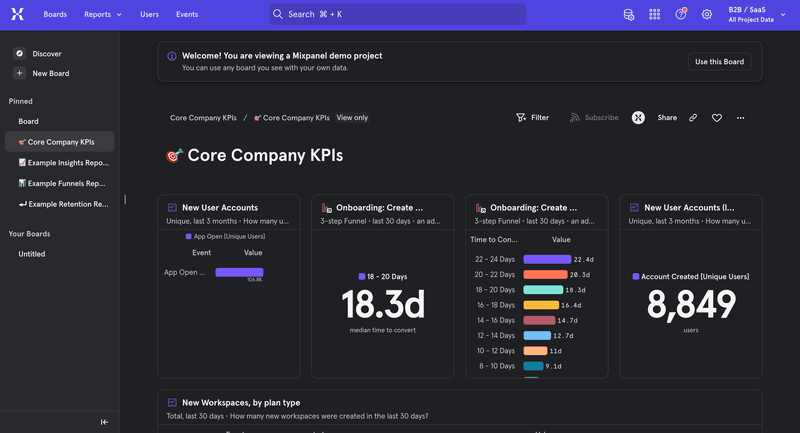
Main features
- Interactive dashboard. Invites users to review patterns and trends by getting granular access to customer data in different categories — e.g., customer interactions, demographics, or account type.
- Customized tracking for goals. Set goals and review the progress on the platform so you and your team can quantify success and work toward the same initiatives.
- Boards. Combine multiple Mixpanel reports, text, and videos to tell a story with your data using a single screen.
Pricing
Mixpanel pricing plans are event-based, so it can get costly as you scale.
Mixpanel offers a free plan with access to 20 million monthly events but limited features. Then, prices start at $28 per month for the same number of events, but access to more advanced features and analytics. For enterprise-level security and up to 1T of monthly events, you need to contact sales.
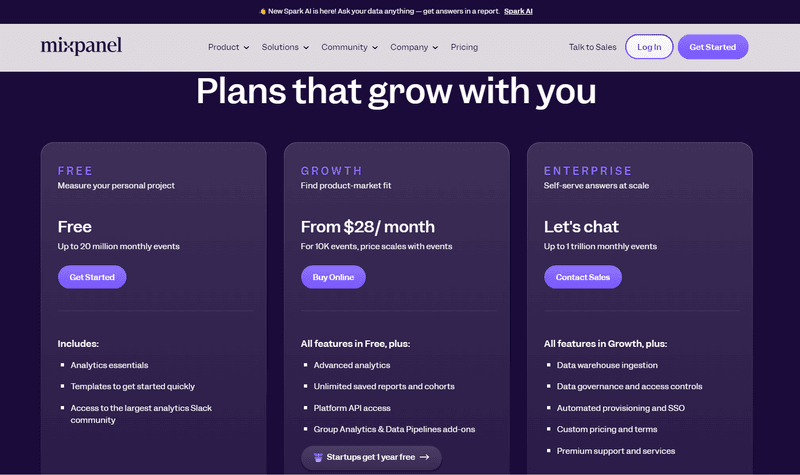
Pendo
This is a product suite for improving the customer’s experience through data. It works both on mobile and websites and for customers and employees.
Pendo Analytics is one of its products. It allows you to track and analyze customer data and monitor customer interactions on your tool.
While Pendo integrates with Slack, it’s not easy to share findings with external stakeholders. “It’s not so easy to share the NPS results with those that aren’t users of Pendo,” says a Pendo user.
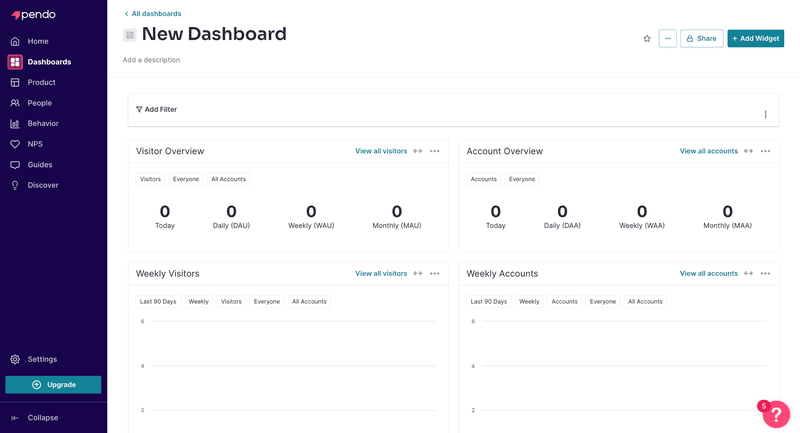
Main features
- Product dashboards and reports. To visualize user data as they go through your funnel and workflows. However, it lacks options to break down data, such as by Plan, Country, Device, Email, Language, etc., as seen in other mentioned tools like Userpilot, in its default reports. If you wish to do so, you must set custom event properties, which involve coding.
- Core events. Define up to ten activities your customers will perform on your platform and review them later by tracking customers’ behaviors.
- Feature adoption. Use this customer tracking software to monitor the adoption of your essential features. Then, analyze the customer data to see which of your key features is the most valued by your users.
Pricing
Pendo offers three plans.
A limited free one for up to 500 MAU (monthly active users). A Growth plan for a single web or mobile app and custom MAU, and a Portfolio plan for unlimited websites and mobile apps. Prices aren’t disclosed online.
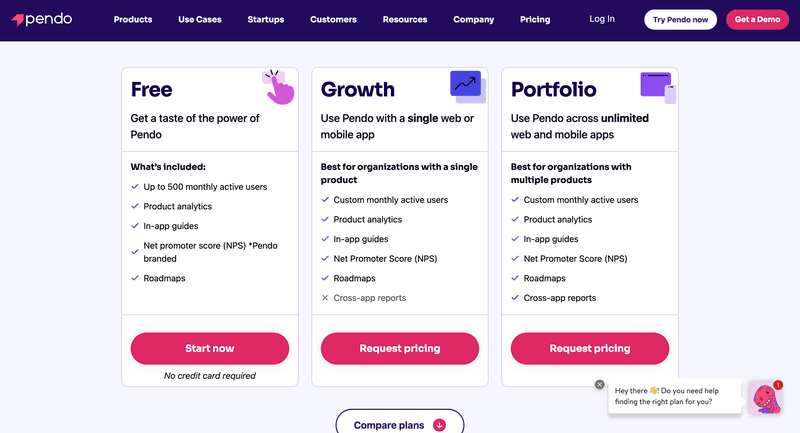
Best tracking tools for customer relationship management
A CRM is different from a customer experience management tool, for example, because the first one monitors customer interactions. However, the best customer experience management tools accompany the creation of a business strategy.
If you’re looking for customer relationship management (CRM) tools for tracking customer interactions across the sales funnel, here are the ones we recommend.
HubSpot
Hubspot is one of the most popular CRM systems in the market. It’s grown a lot in the past few years and now offers a dedicated solution for each aspect of the business, all powered by its CRM. It’s more catered to individuals or front-facing teams.
Users like HubSpot, but feel the CRM is a bit inflexible. “I like the customizable elements of HubSpot reporting and analytics. However, I dislike the lack of customizable sequences in the HubSpot CRM system,” says Hubspot user, Matthew.
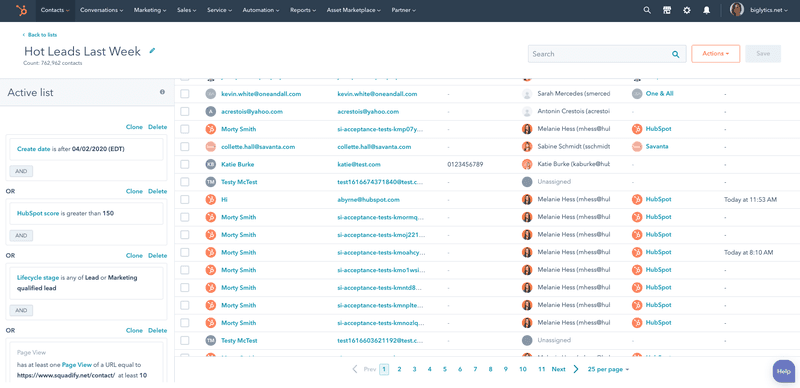
Main features
- Dashboard and reporting software. Build customized reports and interactive dashboards to visualize all business data (coming from other Hubspot products) in one place.
- Company insights. Hubspot uses details from all the other company’s databases hosted on the platform to automatically populate your leads’ data when they change their contact information.
- Pipeline management. Handle your deals in your CRM, move them across the sales journey with a single click, and review their progress in the dashboard.
Pricing
The CRM is available to everyone for free for up to one million contacts and limited features. For a more premium offering, Hubspot has plans for individuals and small teams that range from $15-$90 per seat per month.
Enterprise plans start at $90 and go up to $150 per seat per month.
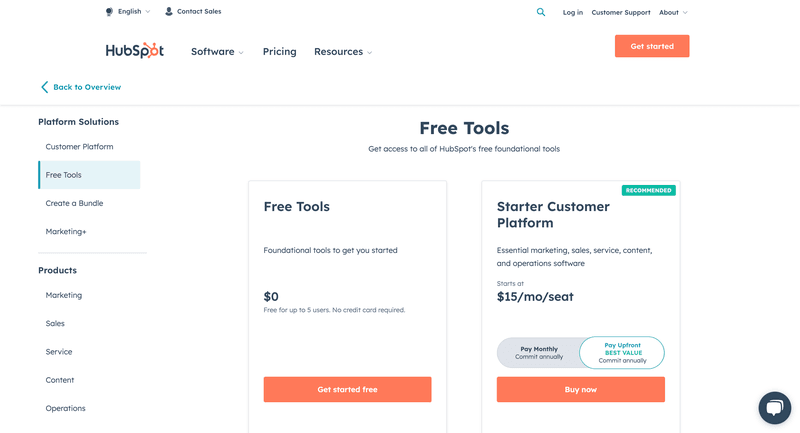
Zoho CRM
Zoho CRM is a cloud-based platform that separates from the idea that CRMs are a ton of manual data entry. This platform also comes with an analytics hub to review everything from lead data to deal insights, including activity metrics, and email analytics.
However, it lacks integrations, according to users. Says Rehan P.: “I like being able to use most of Zoho’s Apps for a low cost per employee. But integrations with other tools are limited.”
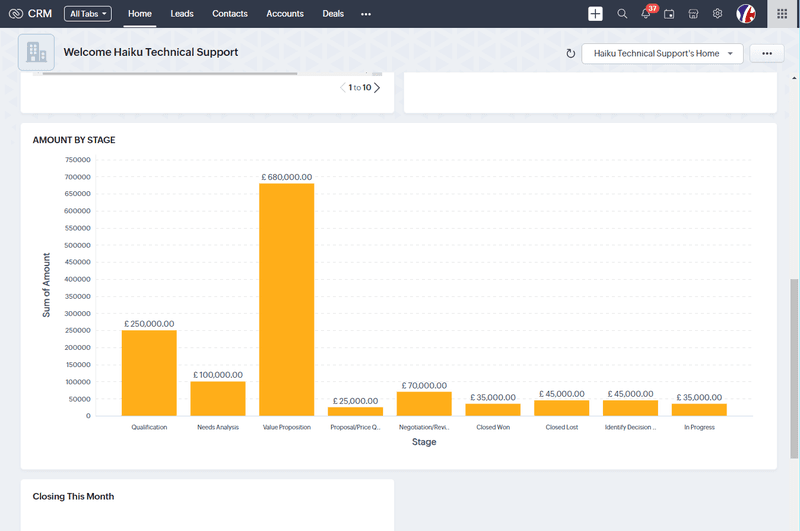
Main features
- Customizable reports. Create your report or choose one from its templates and apply advanced filters to gain insight from your data.
- Anomaly detector. This is an AI-powered widget that compares your actual sales performance to the predicted trend. It also spots any deviations from the projected pattern.
- Target meter. Translate your business strategy and macro-level goals into achievable sales targets. Monitor those metrics and assign benchmarks to each one.
Pricing
Zoho CRM is part of a big suite of business products. Pay for the CRM separately or bundle it with any Zoho app.
Either way, Zoho CRM comes at four different prices. It starts at $12 per user per month and goes up to $45 per user per month for dedicated BI functionality (prices based on annual billing).
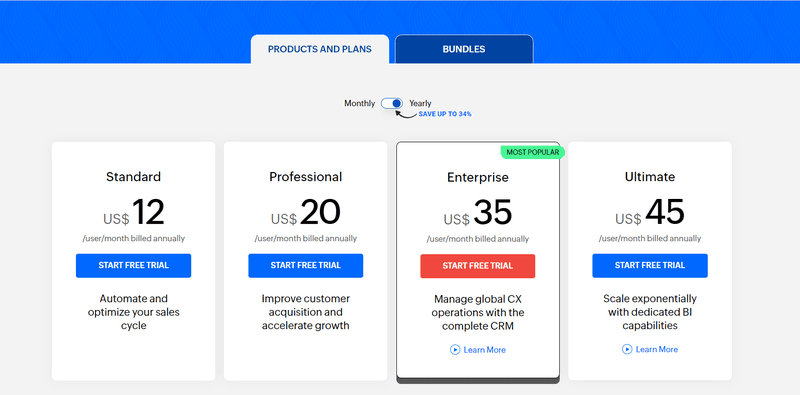
Salesforce
Salesforce is a sales rep’s co-pilot as it enables teams to increase sales and improve productivity. It is mostly suited for mid-to-large businesses and supports multiple industries.
However, some of its users believe it can be pricey. “Salesforce Sales Cloud is the leading CRM tool without any doubt, but it is very expensive,” says Salesforce user, Tanmayi Y..
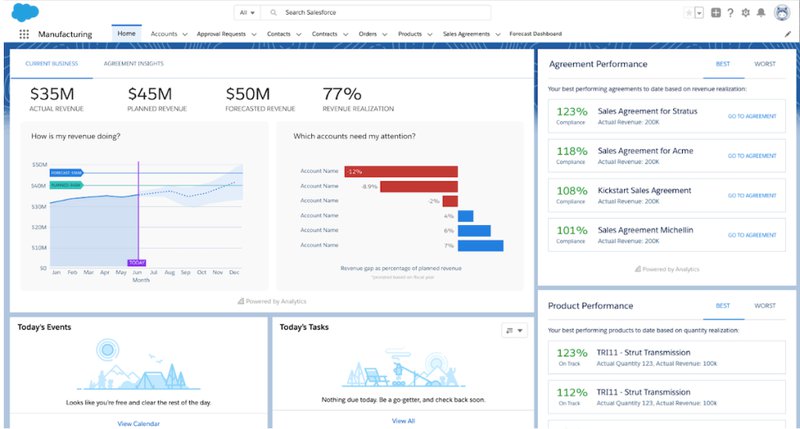
Main features
- AI-driven forecasting. Track sales data and make assumptions to determine how likely a lead is to convert.
- Pipeline inspection. Review everyone in your pipeline to determine who are your top opportunities.
- CRM analytics dashboard. Monitor your sales KPIs easily by building an interactive dashboard. Change the view according to the viewer’s job title for more high-level or granular information.
Pricing
Salesforce offers a 30-day free trial for the CRM.
Then, prices start at $25 per user per month and go up to $500 per user per month for Einstein 1, a Salesforce AI-powered sales tool.
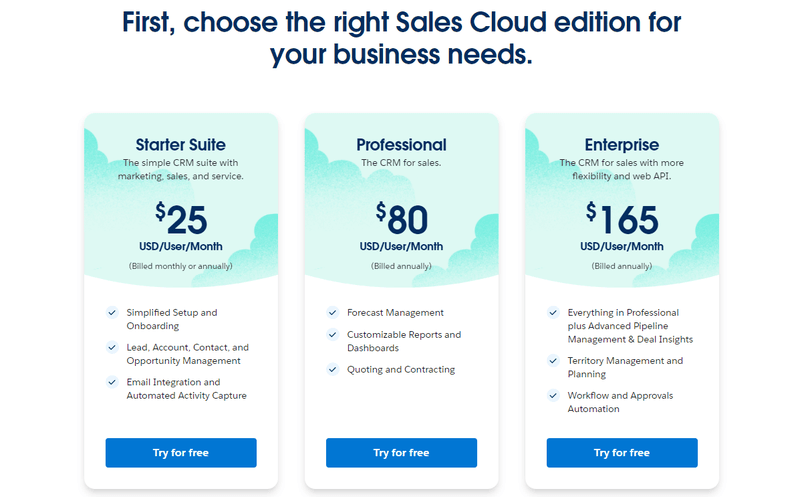
monday.com
monday.com offers three different tools to handle daily business operations. This includes a CRM for the sales team.
Its CRM lets you streamline your sales operations by organizing customer data and building automation.
One thing to note is it can be slow to load. monday.com user, Ramon Antonio B., says: “I was able to navigate through all the features without any problems. But, it’s uncomfortable that sometimes the page loading can be slow.”
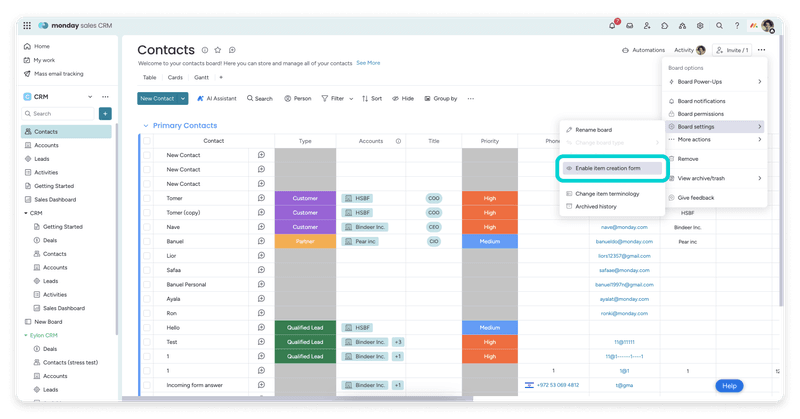
Main features
- Dashboards. Design custom dashboards to review your team’s progress in real-time. Visualize lead status, team workload, budget spent, sales figures, and team performance.
- Automation. Leverage the power of AI to set tasks, notifications, and date reminders, and auto-assign work to others.
- Activity tracking. Store and share customer information and activity for anyone to pick up conversations after reviewing previous meetings, notes, emails, or phone calls.
Pricing
monday.com offers four different plans that start at $12 per seat per month and go up to $28 per seat per month (all billed annually). Enterprise plans are available on a custom quote.
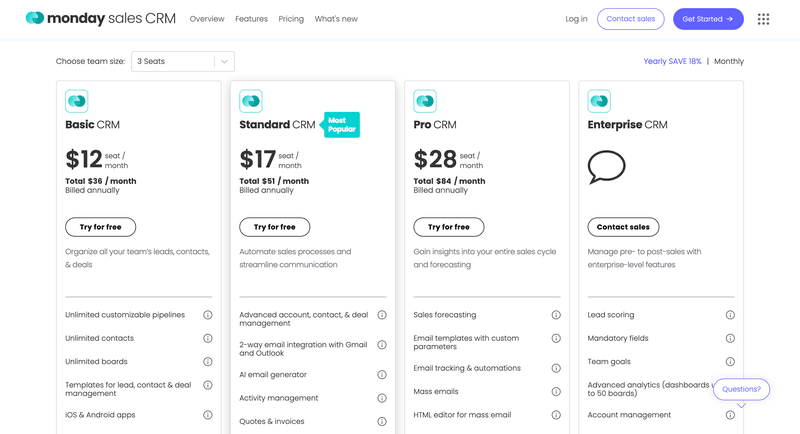
ClickUp
ClickUp calls itself “the everything app” because it lets you manage leads, close deals, store documents, communicate and collaborate with the team, and assign tasks.
As a CRM tool, ClickUp relies heavily on automation and turning data into visuals. It also integrates with over a thousand tools, making it a suitable solution for small to midsize businesses, although it supports enterprises.
One drawback is it can often hurt loading times. That’s what ClickUp user, Neha S., thinks: “ClickUp helps you manage your overall business. However, sometimes it takes time to load and stops working without any notice.”
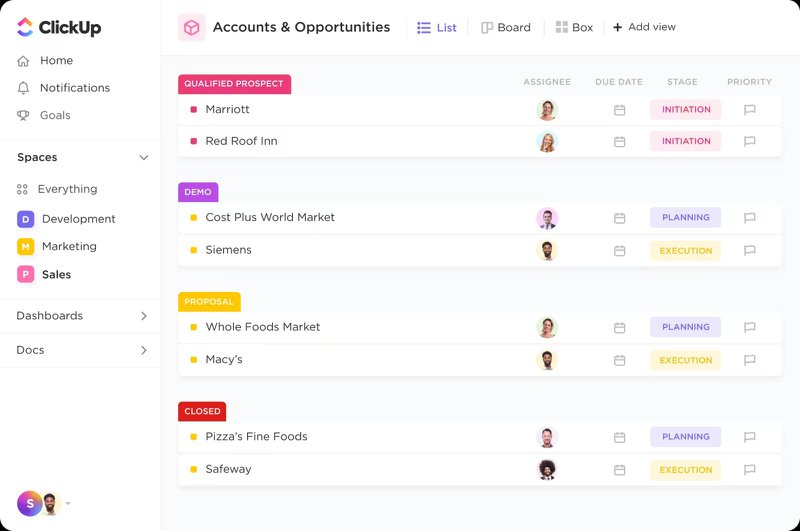
Main features
- Dashboards. Build a dashboard using 50+ customizable widgets, or choose from its template library to manage and view all of your customer data.
- Forms. Improves the way you organize lead information based on form responses. ClickUp automatically creates tasks with branded forms that follow a conditional logic.
- Automation. Auto-send emails to leads, auto-assign tasks depending on conditions, or trigger notifications and updates to team members.
Pricing
ClickUp offers a freemium model. Then, prices start at $7 per user per month and go up to $19 per user per month (billed annually). Enterprise plans are available on a custom quote.

Best customer tracking software for marketing automation
Another way of doing customer tracking is through marketing automation for growth teams. This means, reviewing customer data to feed into your conditional marketing flows.
Here are four marketing automation software we recommend.
Zapier
Zapier enables workflow automation via its connectors that allow you to link all of your apps.
You can use this as part of your customer tracking efforts or to automatically segment customers and trigger marketing campaigns.
However, it has a somewhat steep learning curve. “Zapier is extremely useful when automating processes. But it can be a little difficult to operate for new users,” says a Zapier user.
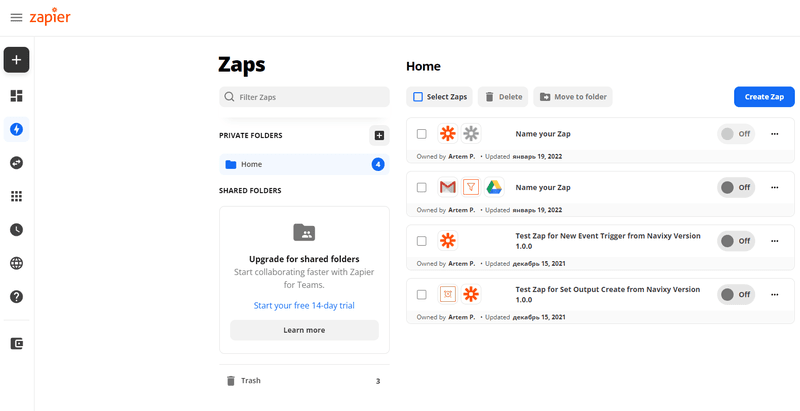
Main features
- Schedule. Trigger tasks, messages, updates, or social media posts based on a set schedule.
- Filter. Assign conditions as filters to allow Zaps to run only if the criteria match.
- Paths. Add criteria to your automated workflows and create multiple pathways so the Zap does A or B depending on the customer behavior.
Pricing
For its Zaps tool, the one for automation features, prices vary depending on functionality and the amount of automation you need.
It’s free for users that automate up to 100 tasks every month.
Then, it goes up to $19,99 per month for 750 tasks, the same tier can go up to $3,199 for over a million tasks.
Zapier’s Team plan ranges from $69 for 2,000 tasks a month and goes up to $3,799 for over a million tasks. Contact the sales team for Zapier’s enterprise-level plans.
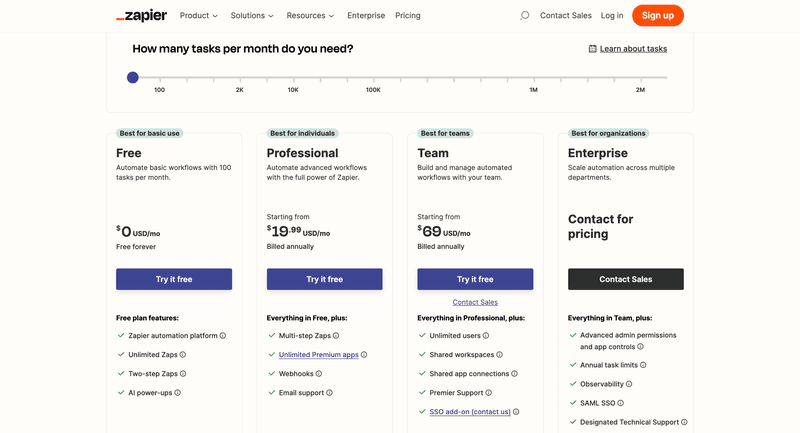
Drip
With Drip, you can plan your end-to-end marketing plan for evergreen content and capture leads all year long by setting up a workflow with triggers and tasks.
Users like it because they can set rules to workflows, but some features are still lacking. Look at Drip user, Anil A., comments: “Automation through their workflows and rules and superior. However, I wish Drip had date-based custom fields and conditions (like, pause/hold until x date).”
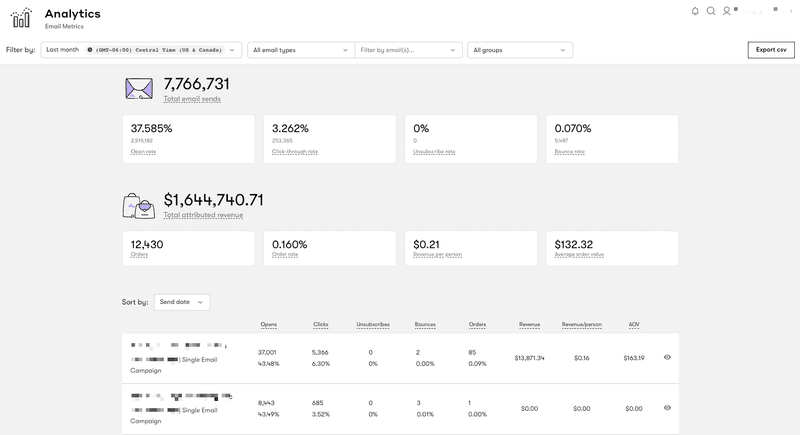
Main features
- Workflows. Connect your e-shop and build tasks around your customers’ actions on-page.
- Dashboard. Review your customers’ insights on a centralized dashboard to zoom in on individuals and make decisions to get them to purchase again.
- Emails. Write, design, and schedule marketing emails based on triggers, segments, and behaviors.
Pricing
Drip offers a 14-day free trial. Then, prices start at $39 per month for up to 2,500 contacts on your email list.
Businesses with over 190,000 contacts, need to reach out to sales for a custom quote.
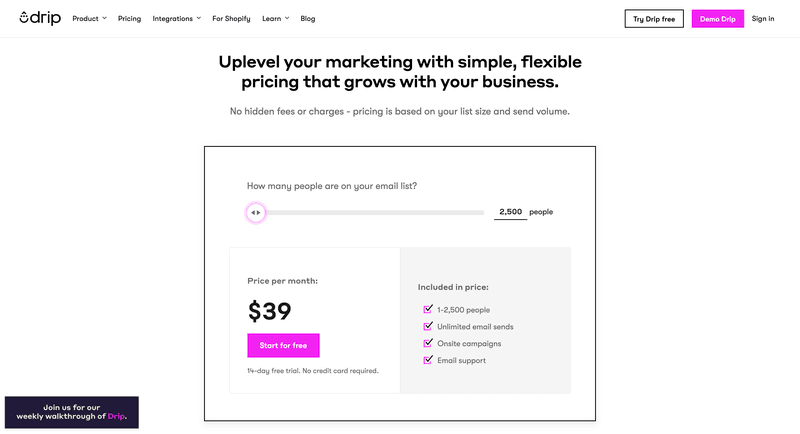
ActiveCampaign
ActiveCampaign lets you build automation to improve your marketing efforts and boost sales. With this platform, you get to connect all of your tools and communication channels and include them in your workflows.
Users agree that ActiveCampaign lives up to its word, but it’s a bit inflexible. “It does simple things well. The dashboard and forms aren’t very customizable,” says ActiveCampaign user.
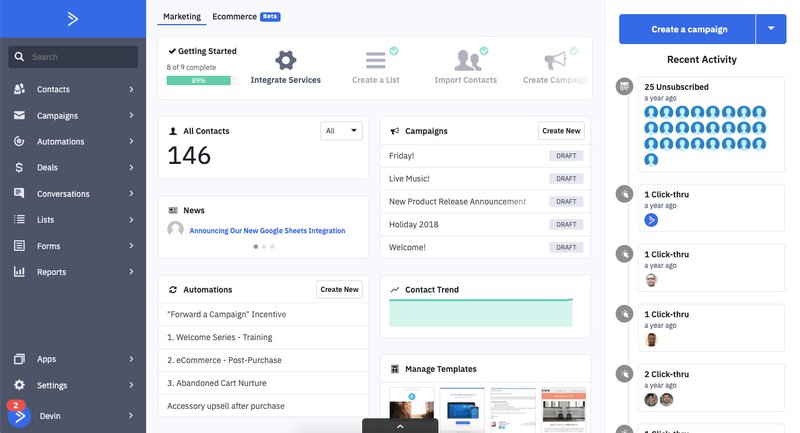
Main features
- Predictive sending. Send emails when each individual user is more likely to engage to increase your open rates.
- Site tracking. Track customers’ behavior to spot which products, services, and information your leads find more interesting.
- Goal tracking. Work towards your business goals by setting specific actions, reviewing its performance, and building user segments to see which performs better.
Pricing
Prices start at $29 per user per month with up to 500 contacts.
Then, prices range from $49 for three users per month with up to 1,000 contacts, to $259 per month for 10 users and up to 2,500 contacts (all based on annual billing).
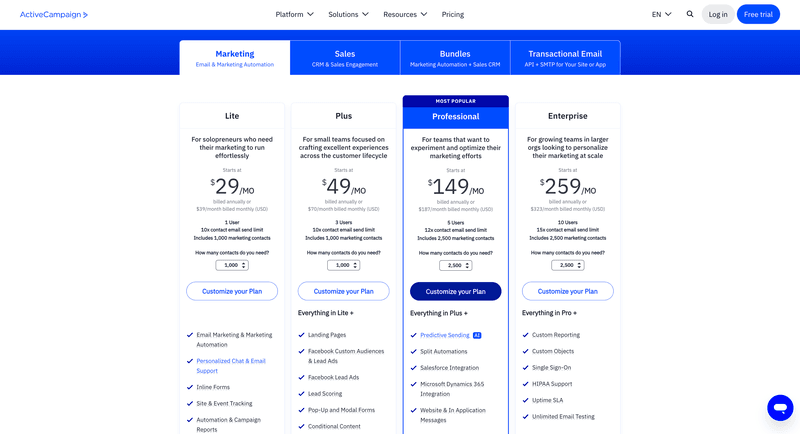
Keap
This all-in-one platform lets you capture, segment, monitor, and retain your leads, as well as giving you access to automation features. Keap is catered to small businesses that want to leverage the power of automation to increase revenue.
However, the UI is a bit inflexible. “It’s a CMS, email marketing, and automation software. But, it’s slow and I would like the UX to be more customizable,” says Keap user.
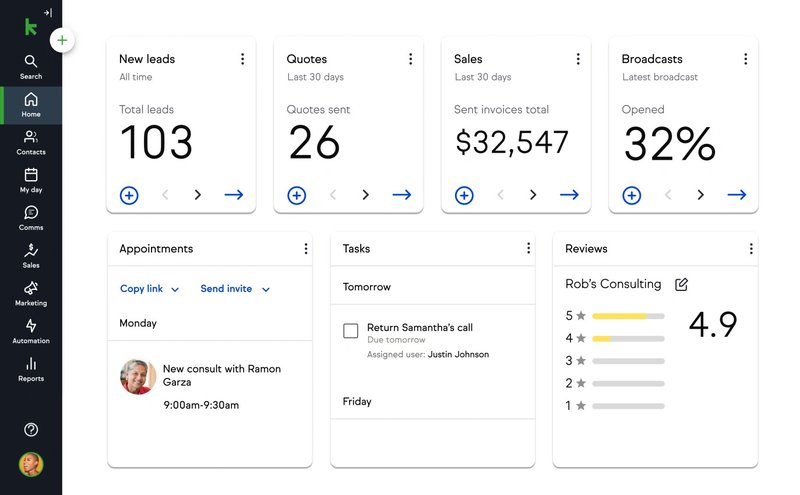
Main features
- Marketing reports. Track conversions based on different metrics and review campaign performance to understand your customers’ behavior.
- Automation. Build your own or choose from a template library to follow up on leads, ask them to book a demo, or send invoice reminders.
- Email management. Write personalized emails, automate responses, and manage deliverability.
Pricing
Keap prices start at $159 per user per month for up to 1,500 contacts. Then, prices jump to $229 for 2,500 contacts and three users per month (all billed annually).
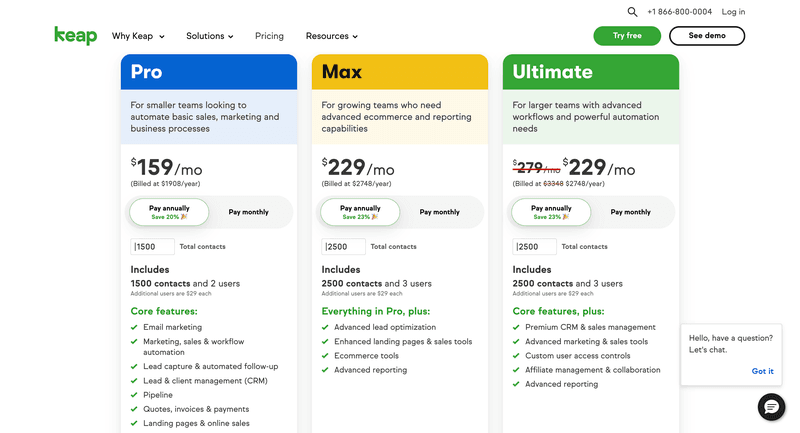
Conclusion
Choosing the right customer tracking software is crucial for boosting your sales and marketing KPIs. We hope the list above helps you with making the final decision.
Interested in building in-app activations that enhance your product, boost retention, and see how your users interact with your tool in one single place? Try Userpilot, get a demo.



